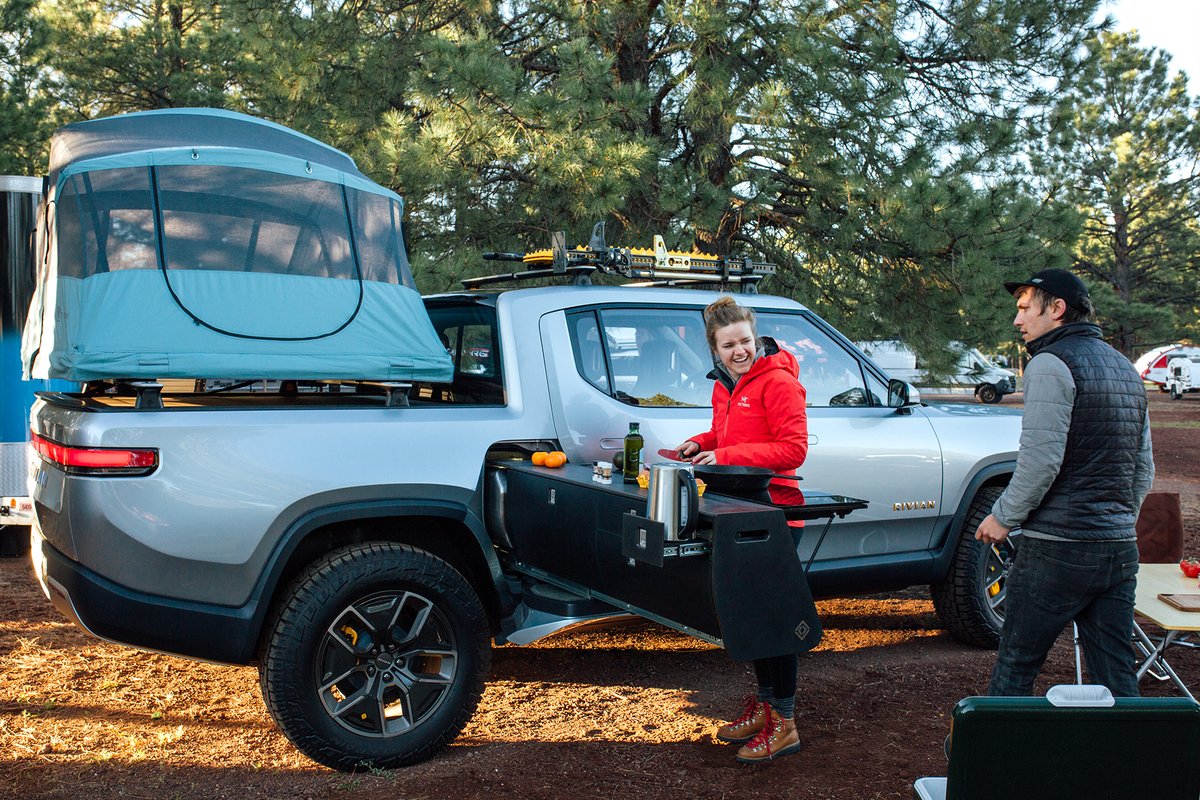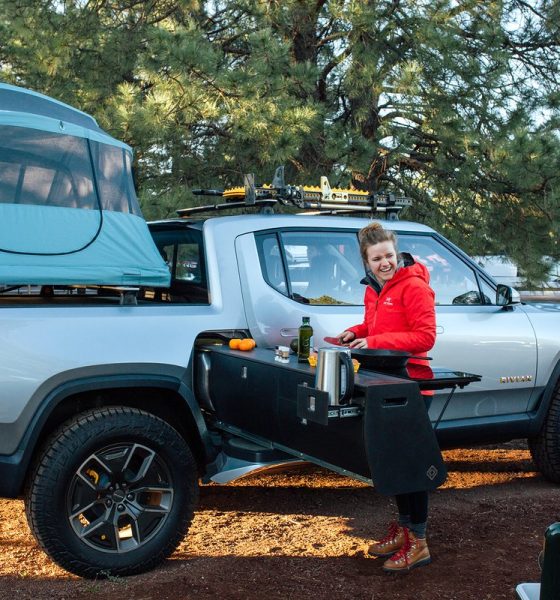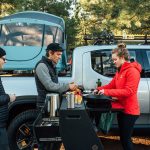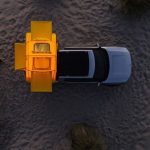

News
Rivian’s R1T electric truck kitchen set was made with sustainable materials
Rivian has a lot of excitement built up for its outdoor adventure brand, and alongside the launch of its all-electric R1T pickup truck and R1S SUV, the company also has plans to launch must-have accessories for new vehicle owners. The most notable of these is the extendable kitchen set designed for the R1T gear tunnel which is constructed with environmentally friendly materials that align with Rivian’s sustainability mission.
A close-up look at Rivian’s portable kitchen was recently published by Tech Crunch from their attendance at the Overland Expo West in Flagstaff, Arizona this past May. The car maker had unveiled the cooking companion at the event, and team members were demonstrating the module’s functionality. Part of Rivian’s branding is centered around being part of a sustainable future as an electric vehicle car manufacturer, and with that in mind, the gear tunnel kitchen uses recycled materials in its frame and work surfaces, specifically the brand Richlite, as revealed in the recent video. Richlite is an ultra-durable, heat-resistant blend of recycled paper and resin that has received several sustainability certifications, including Greenguard Certification for low emissions, Rainforest Alliance Certification, and Forest Stewardship Council Certification, per the company’s website.
Another interesting part of Rivian’s portable kitchen is its induction stovetop and electric kettle; both were designed to tuck away into the kitchen’s frame for maximum usability with minimum storage requirements. Drawers with cork inserts that stabilize utensils and cooking supplies while driving are also included in the design. The kitchen set additionally includes a dish drying rack made from bamboo that folds out of a built-in sink. Finally, there’s a 5-gallon water tank to supply any drinking, cooking, or cleaning needs.
- Rivian’s R1T gear tunnel kitchen set. | Image: Rivian/Twitter
- Rivian’s R1T gear tunnel kitchen set. | Image: Rivian/Twitter
- The Rivian R1T with tent attachment. | Image: Rivian/Instagram
After unveiling its kitchen set, Rivian’s social media focused on promoting the accessory to help jog potential customers’ imaginations and inspire trips of their own with food at the forefront. Two company team members documented a trip to Sedona with the R1T truck over Memorial Day weekend highlighting the kitchen specifically along with a tent that attaches to the truck bed. While this newest gear tunnel addition was only meant to be a prototype to interact with the overlanding community and gain feedback for Rivian’s products, its popularity has convinced the company to offer it as a standard accessory available for purchase when the company fully launches its production vehicles.
The Rivian team is currently hard at work bringing the company up to a high-volume manufacturing level for the R1T and R1S. In the meantime, CEO RJ Scaringe has teased a few other environmentally-focused projects underway. At the company’s manufacturing facility in Normal, Illinois, Rivian is planning an on-site food farm for employees in collaboration with local universities. Also, the car maker recently announced an expansion of its partnership with rock climber Alex Honnold via an energy storage project using the company’s expended car batteries for a micro solar grid in Puerto Rico.
Deliveries of the first customer R1T pickup trucks and R1S SUVs are expected to happen at the end of 2020. Scaringe recently estimated that in 2021, Rivian’s estimated first full year of rolling vehicles through the assembly line, approximately 20,000 to 40,000 cars will be made. Until then, preorders are still open on their website.

News
Tesla (TSLA) receives “Buy” rating and $551 PT from Canaccord Genuity
He also maintained a “Buy” rating for TSLA stock over the company’s improving long-term outlook, which is driven by autonomy and robotics.

Canaccord Genuity analyst George Gianarikas raised his Tesla (NASDAQ:TSLA) price target from $482 to $551. He also maintained a “Buy” rating for TSLA stock over the company’s improving long-term outlook, which is driven by autonomy and robotics.
The analyst’s updated note
Gianarikas lowered his 4Q25 delivery estimates but pointed to several positive factors in the Tesla story. He noted that EV adoption in emerging markets is gaining pace, and progress in FSD and the Robotaxi rollout in 2026 represent major upside drivers. Further progress in the Optimus program next year could also add more momentum for the electric vehicle maker.
“Overall, yes, 4Q25 delivery expectations are being revised lower. However, the reset in the US EV market is laying the groundwork for a more durable and attractive long-term demand environment.
“At the same time, EV penetration in emerging markets is accelerating, reinforcing Tesla’s potential multi‑year growth runway beyond the US. Global progress in FSD and the anticipated rollout of a larger robotaxi fleet in 2026 are increasingly important components of the Tesla equity story and could provide sentiment tailwinds,” the analyst wrote.
Tesla’s busy 2026
The upcoming year would be a busy one for Tesla, considering the company’s plans and targets. The autonomous two-seat Cybercab has been confirmed to start production sometime in Q2 2026, as per Elon Musk during the 2025 Annual Shareholder Meeting.
Apart from this, Tesla is also expected to unveil the next-generation Roadster on April 1, 2026. Tesla is also expected to start high-volume production of the Tesla Semi in Nevada next year.
Apart from vehicle launches, Tesla has expressed its intentions to significantly ramp the rollout of FSD to several regions worldwide, such as Europe. Plans are also underway to launch more Robotaxi networks in several more key areas across the United States.
News
Waymo sues Santa Monica over order to halt overnight charging sessions
In its complaint, Waymo argued that its self-driving cars’ operations do not constitute a public nuisance, and compliance with the city’s order would cause the company irreparable harm.

Waymo has filed a lawsuit against the City of Santa Monica in Los Angeles County Superior Court, seeking to block an order that requires the company to cease overnight charging at two facilities.
In its complaint, Waymo argued that its self-driving cars’ operations do not constitute a public nuisance, and compliance with the city’s order would cause the company irreparable harm.
Nuisance claims
As noted in a report from the Los Angeles Times, Waymo’s two charging sites at Euclid Street and Broadway have operated for about a year, supporting the company’s growing fleet with round-the-clock activity. Unfortunately, this has also resulted in residents in the area reportedly being unable to sleep due to incessant beeping from self-driving taxis that are moving in and out of the charging stations around the clock.
Frustrated residents have protested against the Waymos by blocking the vehicles’ paths, placing cones, and “stacking” cars to create backups. This has also resulted in multiple calls to the police.
Last month, the city issued an order to Waymo and its charging partner, Voltera, to cease overnight operations at the charging locations, stating that the self-driving vehicles’ activities at night were a public nuisance. A December 15 meeting yielded no agreement on mitigations like software rerouting. Waymo proposed changes, but the city reportedly insisted that nothing would satisfy the irate residents.
“We are disappointed that the City has chosen an adversarial path over a collaborative one. The City’s position has been to insist that no actions taken or proposed by Waymo would satisfy the complaining neighbors and therefore must be deemed insufficient,” a Waymo spokesperson stated.
Waymo pushes back
In its legal complaint, Waymo stated that its “activities at the Broadway Facilities do not constitute a public nuisance.” The company also noted that it “faces imminent and irreparable harm to its operations, employees, and customers” from the city’s order. The suit also stated that the city was fully aware that the Voltera charging sites would be operating around the clock to support Waymo’s self-driving taxis.
The company highlighted over one million trips in Santa Monica since launch, with more than 50,000 rides starting or ending there in November alone. Waymo also criticized the city for adopting a contentious strategy against businesses.
“The City of Santa Monica’s recent actions are inconsistent with its stated goal of attracting investment. At a time when the City faces a serious fiscal crisis, officials are choosing to obstruct properly permitted investment rather than fostering a ‘ready for business’ environment,” Waymo stated.
News
Tesla FSD v14.2.2 is getting rave reviews from drivers
So far, early testers have reported buttery-smooth drives with confident performance, even at night or on twisty roads.

Tesla Full Self-Driving (Supervised) v14.2.2 is receiving positive reviews from owners, with several drivers praising the build’s lack of hesitation during lane changes and its smoother decision-making, among others.
The update, which started rolling out on Monday, also adds features like dynamic arrival pin adjustment. So far, early testers have reported buttery-smooth drives with confident performance, even at night or on twisty roads.
Owners highlight major improvements
Longtime Tesla owner and FSD user @BLKMDL3 shared a detailed 10-hour impression of FSD v14.2.2, noting that the system exhibited “zero lane change hesitation” and “extremely refined” lane choices. He praised Mad Max mode’s performance, stellar parking in locations including ticket dispensers, and impressive canyon runs even in dark conditions.
Fellow FSD user Dan Burkland reported an hour of FSD v14.2.2’s nighttime driving with “zero hesitations” and “buttery smooth” confidence reminiscent of Robotaxi rides in areas such as Austin, Texas. Veteran FSD user Whole Mars Catalog also demonstrated voice navigation via Grok, while Tesla owner Devin Olsen completed a nearly two-hour drive with FSD v14.2.2 in heavy traffic and rain with strong performance.
Closer to unsupervised
FSD has been receiving rave reviews, even from Tesla’s competitors. Xpeng CEO He Xiaopeng, for one, offered fresh praise for FSD v14.2 after visiting Silicon Valley. Following extended test drives of Tesla vehicles running the latest FSD software, He stated that the system has made major strides, reinforcing his view that Tesla’s approach to autonomy is indeed the proper path towards autonomy.
According to He, Tesla’s FSD has evolved from a smooth Level 2 advanced driver assistance system into what he described as a “near-Level 4” experience in terms of capabilities. While acknowledging that areas of improvement are still present, the Xpeng CEO stated that FSD’s current iteration significantly surpasses last year’s capabilities. He also reiterated his belief that Tesla’s strategy of using the same autonomous software and hardware architecture across private vehicles and robotaxis is the right long-term approach, as it would allow users to bypass intermediate autonomy stages and move closer to Level 4 functionality.











